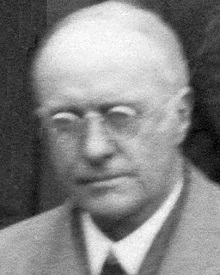Biography:Theodore Lyman
Theodore Lyman | |
|---|---|
 | |
| Born | November 23, 1874 Boston, Massachusetts |
| Died | October 11, 1954 (aged 79) Cambridge, Massachusetts |
| Alma mater | Harvard University |
| Awards | Elliott Cresson Medal (1931) |
| Scientific career | |
| Fields | Spectroscopy |
This article does not cite any external source. HandWiki requires at least one external source. See citing external sources. (September 2017) (Learn how and when to remove this template message) |
Theodore Lyman (/ˈlaɪmən/; November 23, 1874 – October 11, 1954) was a United States of America physicist and spectroscopist, born in Boston. He graduated from Harvard in 1897, from which he also received his Ph.D. in 1900.
Career
This section does not cite any external source. HandWiki requires at least one external source. See citing external sources. (September 2017) (Learn how and when to remove this template message) |
Lyman became an assistant professor in physics at Harvard, where he remained, becoming full professor in 1917, and where he was also director of the Jefferson Physical Laboratory (1908–17). He made important studies in phenomena connected with diffraction gratings, on the wavelengths of vacuum ultraviolet light discovered by Victor Schumann and also on the properties of light of extremely short wavelength, on all of which he contributed valuable papers to the literature of physics in the proceedings of scientific societies.
Military service
This section does not cite any external source. HandWiki requires at least one external source. See citing external sources. (September 2017) (Learn how and when to remove this template message) |
During World War I he served in France with the American Expeditionary Force, holding the rank of major of engineers.
Legacy/honors
This section does not cite any external source. HandWiki requires at least one external source. See citing external sources. (September 2017) (Learn how and when to remove this template message) |
- He was the eponym of the Lyman series of spectral lines.
- The crater Lyman on the far side of the Moon is named after him.
- He was awarded the Franklin Institute's Elliott Cresson Medal in 1931.
Affiliations
This section does not cite any external source. HandWiki requires at least one external source. See citing external sources. (September 2017) (Learn how and when to remove this template message) |
He became a hereditary member of the Military Order of the Loyal Legion of the United States in succession to his father, Lieutenant Colonel Theodore Lyman III.
References
 This article incorporates text from a publication now in the public domain: Gilman, D. C.; Peck, H. T.; Colby, F. M., eds (1905). "article name needed". New International Encyclopedia (1st ed.). New York: Dodd, Mead.
This article incorporates text from a publication now in the public domain: Gilman, D. C.; Peck, H. T.; Colby, F. M., eds (1905). "article name needed". New International Encyclopedia (1st ed.). New York: Dodd, Mead.- USGS Gazetteer of Planetary Nomenclature Feature Information
- 1931 Frederic Ives Medal
External links
| Academic offices | ||
|---|---|---|
| Preceded by Wallace Clement Sabine |
Hollis Chair of Mathematics and Natural Philosophy 1921–1926 |
Succeeded by Percy Williams Bridgman |

